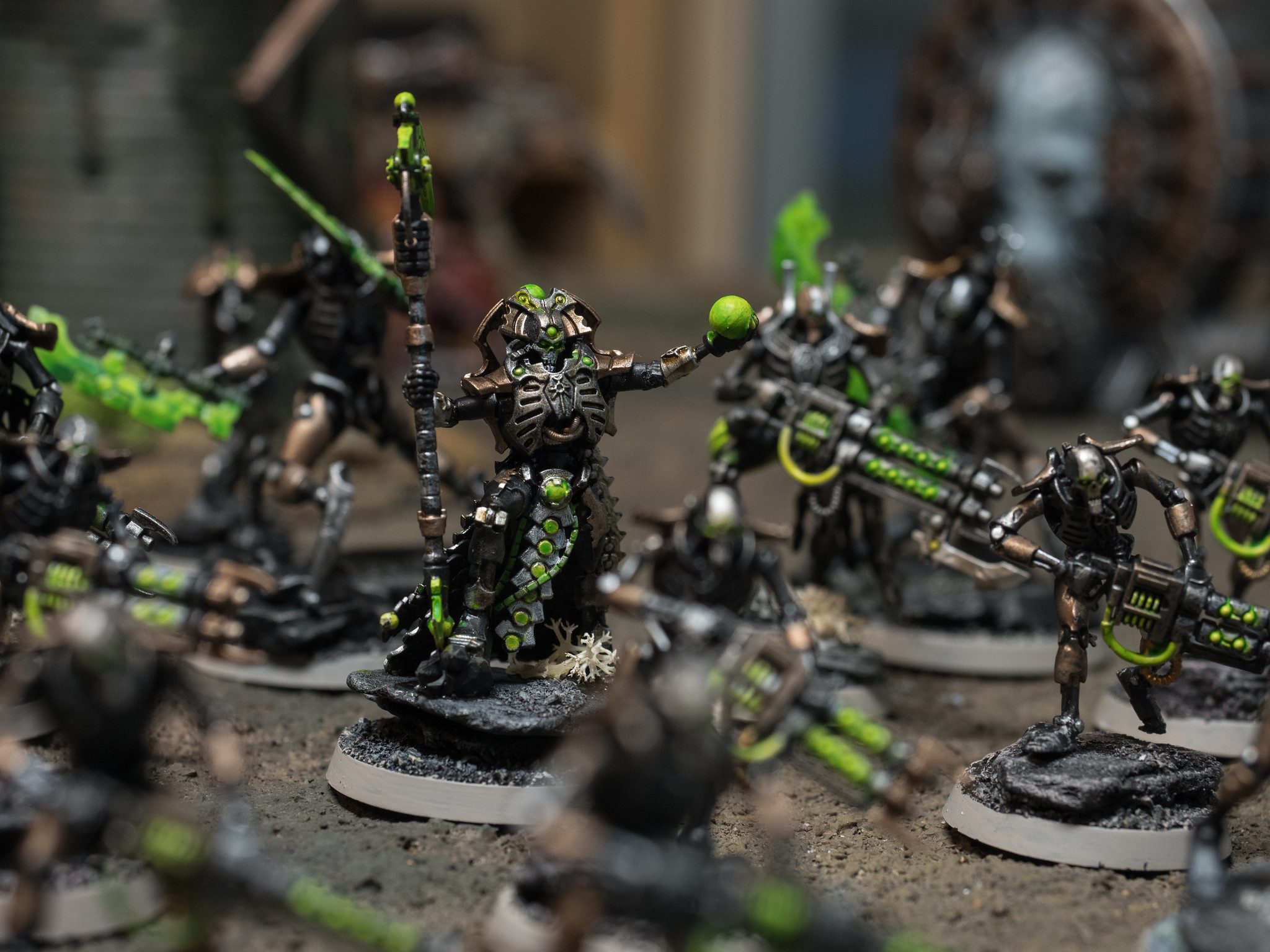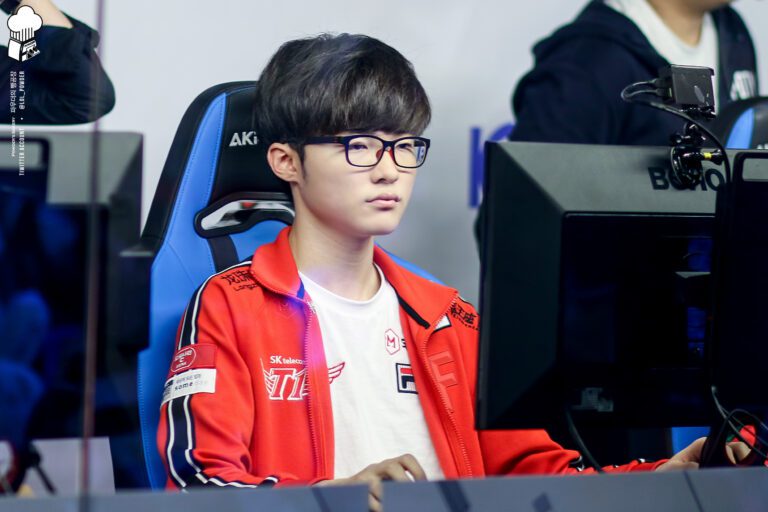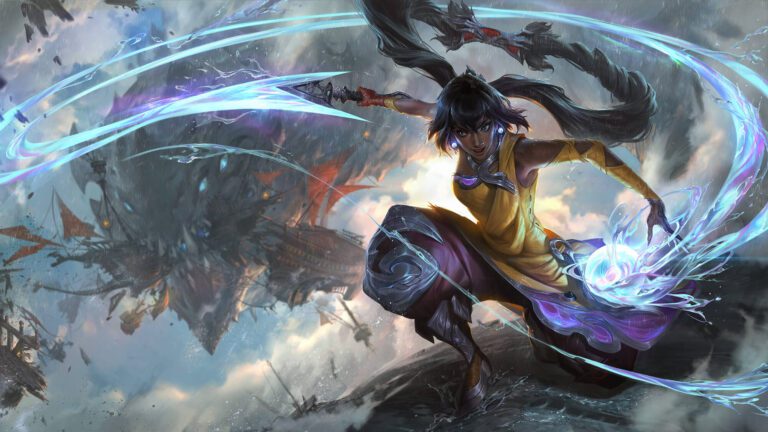Games Workshop and its business model
Games Workshop faces a new fundamental challenge on its business horizon: consumer-grade 3D printing.
For decades the UK-based company has managed to establish itself as the undisputed wargaming giant, barely facing any serious competitor in this subsegment of the tabletop market.
Pouring resources into the development and promotion of its two most notable IPs, Warhammer Age of Sigmar (previously known as Warhammer Fantasy) and Warhammer 40.000, during the latter half of the 2010s Games Workshop achieved immense revenue growth which propelled its stock to prices up to twenty times greater than their prior usual.


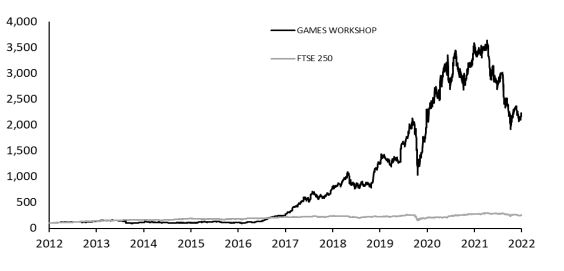

Shareholder return performance compared against the FTSE 250 Index.
Even if we keep in mind the law of diminishing returns, particularly when it comes to economies of scale, GW’s market cap lands it comfortably around the middle of the FTSE 250, so the comparison is pertinent.It is this strong showing of results that which has convinced firms like BlackRock, Vanguard Group or JP Morgan to invest in the company.
Despite relying upon several income streams to sustain its business model, much of Games Workshop’s revenue comes from the sale of plastic or resin miniaturized figurines players paint, collect and use to build their armies so they can then battle with them, either casually or in a tournament setting.
This sales success comes as a by-product of being able to sell at retail prices that are significantly above the competition. GW can get away with this because no other company has created such a cohesive and immersive product that spans across several conversion channels.
Funneling with books, video games, and other media (a sizable part of it being community-made), GW promotes gargantually large universes that brim with diversity, being actual labyrinths of lore consumers can and do get lost in.
Meanwhile, a strong distribution network of more than 500 official and 6000+ independent retail stores allows GW to interact with customers, being able to influence their overall experience and purchasing decisions.
Once a part of the hobby, customers are nudged into buying an array of miniatures, paint, paint brushes, army, and lore books alongside other sorts of hobby material.
And as it has to happen with other viable competitive game companies, engagement is also maintained via metagame renewal and manipulation.
As per Games Workshop’s own annual report, sales in their own physical stores account for 23% of their revenue, with 55% of it coming from third-party retail and 22% from their own official web store.
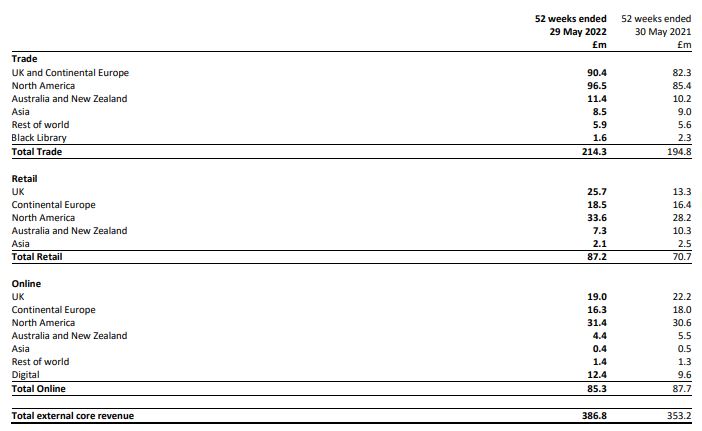

Segmented revenue 2022.
Notice how the Black Library, one of the most important segments regarding construction of Warhammer lore along with army “Codexes”, represents a minor fraction of revenue for Games Workshop, yet its development is relevant as it is a driving force in the creation of stories later popularized by content creators and players.Licensing, not shown here, accounts for up to 28 million pounds. Both Library and licensing point to how alternative products, which are least susceptible to be harmed in the future, conform a minority of GW’s overall revenue.
The looming threat of 3D printing
Having reaped the “spoils” of being at the top of the wargaming market, Games Workshop has been able to raise prices consistently throughout its history. Banking on their possession of both the best lore and consumer minis for play, the company could sit somewhat comfortable in its position.
Despite the success of the actual business, certain customers have often complained about the prices charged for products, deeming them too expensive.
The company’s public image is also not helped by its insistence in, for example, aggressively tradermaking sci-fi terms such as “space marine” or cracking down on YouTube creators that produced content which ultimately played a key role in reviving interest for their franchises during the last decade.
Sticking to the miniatures themselves, Games Workshop grew during a time where no average user had access to a 3D printer, and the ones that did would face high material costs, which rendered the activity of printing your own sculptures inefficient. Quality was yet another constraint, as early printers would glitch often and either ruin a batch or generate too many random objects during the production process.
Those days are mostly gone now.
At the time of writing, consumers can already buy decent printers for a comparatively low price, with production costs and build quality standing against that which Games Workshop has to offer.


Barriers to entry thus being lowered, the democratization of 3D printing represents a power shift to the stakeholders in the industry as it directly or indirectly favors users who now can choose to print their own customized set of miniatures, Warhammer inspired or otherwise.
Those with a 3D printer can go into an open repository or an asset market where they can download files that serve as the blueprint for the printer to follow.
Naturally, as it is bound to happen with any technology of the internet era, piracy has ensued.
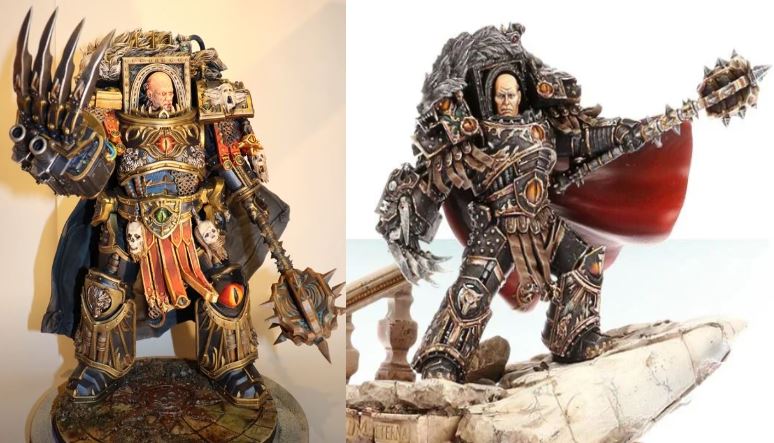

Left - War Master Horse - 5 euros in resin costs
Right - Warmaster Horus - 99 eurosPrices and bargaining power
Roughly speaking, in most markets supply and demand are the opposing forces that determine the price of a good.
When a significant level of consumers stop buying the offered products or service, a signal is actively being sent to the company. While multiple options may pursued at the same time, the business may usually react by either improving quality to justify its prices or by lowering them so as to regain demand.
Alternatively, and arguably what Games Workshop has been doing in recent years, a third option which can work is to try and focus on customer segments whose willingness to pay at stronger price levels remains mostly inelastic.
This strategy, often targeted at so-called “whales”, has done quite well for game companies who implement, for example, microtransactions or expansion packs into their titles. Hence, a minority of low-risk high-reward customers end up bringing the bulk of the company’s revenue.
Regarding the games industry, this enterprise approach, while proven quite successful, comes with at least five potential caveats:
- By relying upon a small subset of players, the individual revenue/customer ratio of the business is higher. Each misstep from the company side then has greater negative impact.
- Even when there is no misstep, if for any reason a decline in popularity takes place, high entry costs are likely to deter new customers from replacing abandoning ones, causing playerbase net loss.
- While it is the duty of any business to maximize its value and profitability, a company with a track record of high-price setting is more likely to receive negative press, especially in the gaming sphere. This principle does not hold, for example, in markets that temporarily follow a Veblen good curve.
- Enticed by the expectations of high profit margins (GW’s is at around 25%), other companies are likely to enter the market, therefore competing against the incumbent(s) within the niche.
- If a critical mass of players abandon the IP, a chain reaction can follow where whales no longer have an incentive to stay and keep buying.
Remember that, while playing a critical role in Warhammer’s popularity, lore material and licensing agreements are mostly employed as funneling channels rather than strong standalone products for Games Workshop: the money is in the minis.
Lore is easy to spread around because of the network effects of the internet, so the awareness of people regarding Warhammer expands, yet miniatures themselves do not see a substantial improvement if the alternative to not buying them becomes prevalent.
Should 3D printing get enough traction, the Games Workshop pricing model will encounter strong downward pressure due to players now being able to merely consume the parts of the lore they like while having an option that provides a similar experience at a way lower cost, therefore threatening GW’s previously uncontested business model.
Can Games Workshop do anything about 3D printing?
In this particular case, the threat of 3D printing is one that cannot be directly dealt with.
Enforcing copyright over the vast hub that is the world wide web is extremely hard if not impossible, and it is not as if much of the 3D printing that users perform can even qualify as IP infringement.
Plenty of 3D modelers just use Warhammer designs as a template, apply a few modifications or change the poses of the renders before uploading them with names which mock the franchise. Users can search for them easily, while GW cannot claim ownership over them.
Warhammer 40K “copycats” thus become BattleMace 40 million or Spacemace69, Tyberos the Red Wake of the Space Sharks becomes the Shark Daddy, Dante the leader of the Blood Angels becomes the Lord of Blood, etc.
Some of these parallel projects actually have some popularity, as independent creators launch Patreon channels which GW cannot easily attack. Such has been the case of YouTube user “Gamza”, who once had a notice dropped against him.
Unable to employ direct measures that hinder 3D printing practices, Games Workshop can take action by increasing group awareness and bannings.
Official tournament stores can void access to players coming with non-official miniatures. Yet at most this is a minor inconvenience for those that attach themselves to the hobby in a non-competitive way.
Games Workshop already bans players when it detects recasts, which before 3D printing were the de facto counterfeiting method (in this instance being actual counterfeiting, for recasted models are exact replicas of the ones sold by Games Workshop, using the same molds).
Counting on players themselves to shame others for saving money is a bad idea. Therefore, it seems that Games Workshop will have to make the prospect of printing as unattractive as it can possibly be.
In a business scenario where 3D printing becomes the norm, the only way GW could realistically react is by lowering prices and progressively shifting from a premium approach to a mass-market one, expecting that via low prices the company witnesses a possible giant surge in customer count.
Diversification is also strongly recommended. In particular, Warhammer has at its disposal a wealth of grim stories that are surprisingly well-written; it could use them to create series or films that, if well executed, could yield decent returns while boosting merchandise. On this terrain GW is actually doing a good job, as plans for Warhammer series have already been laid out.
Additionally, Warhammer+ is a service that has already set out to do a similar thing at a much lesser scale, but it is unclear whether it will really take off considering the lengths the company took to shut down video content which was already up for free on YouTube.
It is my belief and that of many others that topics like The Horus Heresy, a futuristic time-period during which nine demigods pledge themselves to the gods of chaos and plunge the entire galaxy into a civil war, are worth exploring from a visual storytelling standpoint.
At any rate, regardless of whether or not the technology ends up becoming the paradigm, 3D printing is here to stay.
Games Workshop can no longer sit comfortably knowing that there are no true opponents in sight.
Also available in:





